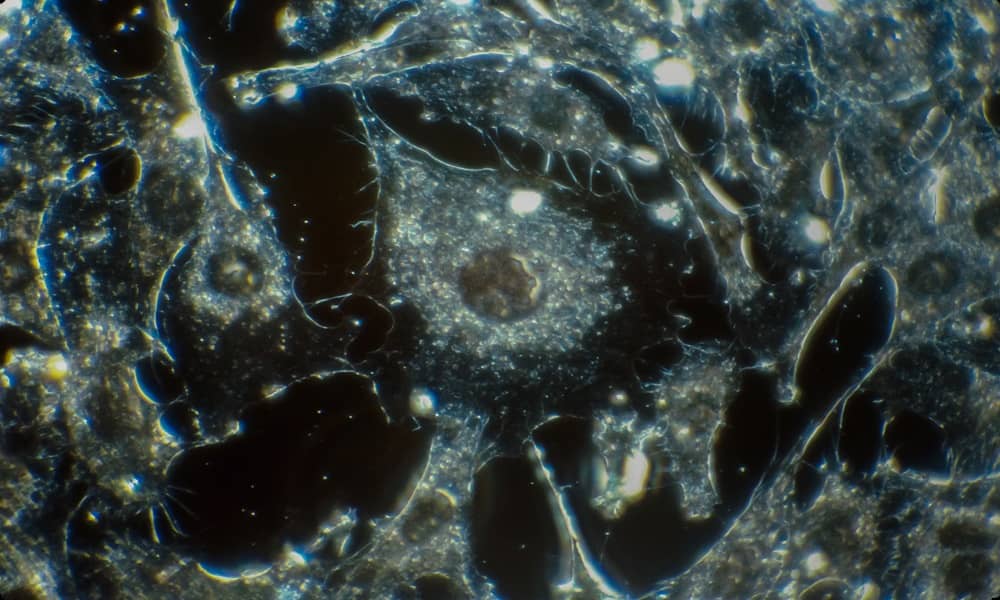
03 Feb 7 Cancer Types W/ Common Symptoms | Causes and Treatment
Cancer is a group of diseases arising from the neoplastic growth of the normal cells in your body. Cancer has many types with a large variety of symptoms and causes.
Pathologically, it is characterized by a mass of cells showing uncontrolled and purposeless growth even after terminations of stimulus.
This mass of cell is called neoplasm which gives rise to two types of tumor:
- Benign – A compact mass of cells of well-defined shape that doesn’t invade the surrounding tissues and is less harmful.
- Malignant – Irregular mass that invades and continues to grow through the adjacent tissues forming a secondary continuous tumor.
Benign tumors are generally not referred to as cancer because of their inability to spread to different regions of the body.
On the other hand, malignant tumors give rise to dreadful cancers that might be treated; there is no certainty!
These two types of growth are further classified into different types of cancers, which we would discuss in the following sections.
Types of Cancer – Identifying the Difference between Different Cancers
Cancer is mainly classified based on its site of origin, tissues involved, grade of cancer, and finally the stages.
While identifying cancer based on its grade and stage can only be done by laboratory diagnosis, it is easy to identify cancer through the tissues.
There are mainly six types of cancers based on the tissues involved:
- Carcinoma – Mainly involves the epithelial lining of body cavities and internal organs. They account for 80 to 90 percent of cancer cases around the world. The two most common types of carcinoma include adenocarcinoma affecting glands and squamous cell carcinoma.
- Sarcoma – The tumor in muscles, bones, cartilage, and fat gives rise to sarcoma. For example, the sarcoma in bones is referred to as osteosarcoma.
- Myeloma – The cancer of the plasma cells of bone marrow is called myeloma. It is a form of blood cancer.
- Leukemia – It is a group of cancer that is characterized as blood cancer since they affect the bone marrow. There are many types of leukemia that we will discuss later.
- Lymphoma – Cancer of the lymphatic system is called lymphoma.
- Mixed types – These types of cancer involve more than one type of cell.
Moreover, there are many more predominant types of cancers on the basis of site of origin. Further in the blog, you’ll find the explanation of 7 common types of cancers with their symptoms and leading causes.
7 Types of Cancer and Symptoms Explained
Right below we have listed down 7 common types of cancer along with their symptoms and causes.
#1. Leukemia
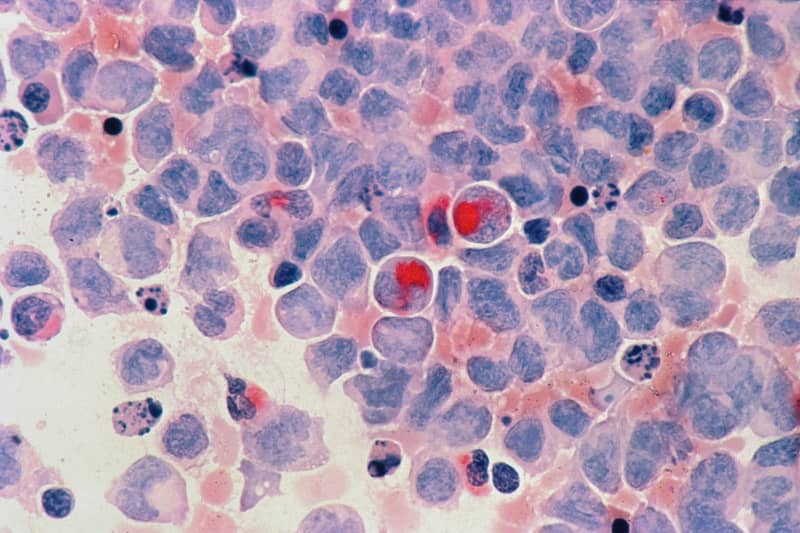
Leukemia is a group of cancers that come under the category of blood cancer.
They influence the production of blood cells by affecting the bone marrow. It can affect any age group but is predominant among children below the age of 15.
Based on the blood cell that undergoes abnormal growth, they are classified as:
- Lymphoblastic Leukemia – It affects the growth of lymphoblasts – T lymphoblasts and B lymphoblasts (responsible for immune responses).
- Myeloid Leukemia – This is essentially excessive growth of the white blood cells of the myeloid series.
They can further be of two types either acute or chronic based on the appearance of precursors of cancer.
Leukemia Symptoms
Different types of leukemia might show different specific symptoms. For example, the lymphoblastic leukemia symptoms could be less severe as compared to myeloid leukemia.
But all types of leukemia show some common symptoms that make them different from other forms of cancer.
- Systemic effects of Leukemia: Weight loss, fever, and exposure to infections
- Effects on respiratory system: Causes shortness of breath and weakness of the muscles in the bronchioles.
- Skeletal System: Common episodes of pain in joints and the bones feel tender and become prone to fractures.
- Effects on skin: Can show symptoms like night sweats, easy bleeding, and bruising with the appearance of purple patches on the skin.
- Enlargement of the spleen and liver.
- Swelling in the lymph nodes.
Some other symptoms can also be seen in the following types of Leukemia.
Acute myeloid leukemia symptoms may carry different symptoms!
- Presence of anemia before a person is diagnosed with myeloid leukemia.
- Bruises, petechiae, and bleeding from the gums become common episodes.
- You become prone to infections of the mouth, lungs, skin, and other sites.
- Inflammation of the gums.
NOTE: Acute lymphoblastic leukemia symptoms are similar to the ones seen in myeloid leukemia.
Causes Or Etiology of Leukemia
The most common causes behind Leukemia are:
- Genetic Factors – Mutations of the DNA of your blood cells can cause leukemia by affecting their regular pattern of growth.
- Infectious agents – Causative agents like the Human T Cell leukemia-lymphoma virus type 1.
- Local factors – Ionizing radiation, certain drugs, benzene and petrochemicals, electromagnetic energy, and even chemicals used in cosmetics.
- Chemotherapy agents used to treat previous cancer.
- Diseases that weaken immunity – Diseases that affect your immunity like AIDS can pave way for Leukemia and other forms of cancer.
- Excessive use of nicotine like in tobacco.
#2. Oral Cancer
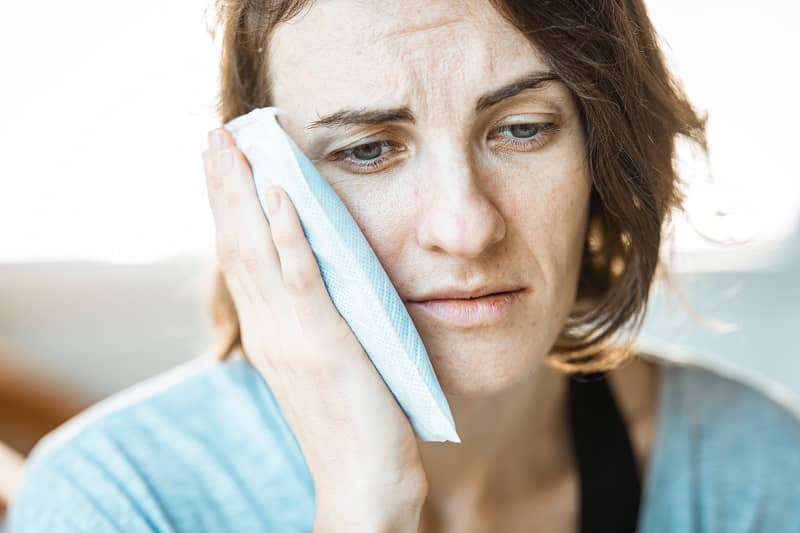
Oral cancer is a group of disorders affecting lips, tongue, cheeks, palate, the floor of the mouth, and other parts of the oral region.
These cancers are characterized by the formation of mass that can be ulcerating or non-ulcerating.
In most cases of oral cancers, commonly red or white patches appear in the mouth.
If not treated early, oral cancers can be fatal, and the worst part, mostly oral cancer is diagnosed at an advanced stage.
However, earlier diagnosis helps in the complete eradication of oral cancer and, thus, one must be cautious about its symptoms.
Symptoms of Oral Cancer
- Swellings in the oral region – Appearance of lumps or areas of erosion at sites like lips, gums, gingiva, or buccal (cheeks) area.
- Patches – It is among common tongue cancer symptoms and can range from being velvety red to raised white.
- Bleeding in the mouth with no prominent sign of injury or pain.
- Problems in opening your mouth or mastication – Sometimes you might find it difficult to control your jaws and hence find difficulty in swallowing and speaking.
- Paralysis – Loss of feeling in any area of the face making you numb.
- Halitosis – Bad breath is a common sign of cancer.
- A sore throat that leads to a hoarse voice can be a sign of throat cancer.
- Ill-fitting dentures – People wearing dentures find it difficult to remove or put in the denture.
- Unexplained weight loss
The symptoms help in the early diagnosis of oral cancer and are treatable. But prevention is better than cure and avoiding the avoidable causative agents is the best prevention.
Causes of Oral Cancer
Oral cancer is multifactorial and the common causes include:
1. Predisposing Factors
- Tobacco consumption – People who chew tobacco are 50 times more likely to suffer from oral cancers than those who don’t. Further smoking too releases high amounts of tobacco products in the mouth that can cause various oral cancers.
- Alcoholism – Excess consumption of alcohol can cause various types of cancer including oral cancer.
2. Environmental Factors
- Industrial pollutants
- Radiation
- Natural carcinogenic agents
3. Immunosuppressive Disorders
- Plummer Vinson syndrome – Causes chronic irritation in the mouth among people suffering from long-term iron deficiency anemia. This chronic irritation often develops into oral cancer.
- Syphilitic glossitis – The syphilitic lesions of the oral cavity can also pave the way for the development of oral cancer.
- Candida albicans – Fungal infections during immunosuppressive disorders can cause chronic irritation of the mouth.
#3. Thyroid Cancer

Thyroid cancer is initially asymptomatic but later shows symptoms in advanced stages.
Since there are many cells present in the thyroid gland, they are further classified into 4 major types based on cells involved:
- Papillary thyroid cancer – Affects the storage of thyroid hormones as they are derived from follicular cells.
- Anaplastic thyroid cancer – It is a rare type of thyroid cancer derived from follicular cells.
- Follicular thyroid cancer – They too affect the follicular cells.
- Medullary thyroid cancer – They begin in the C cells which are responsible for the production of calcitonin.
Though most of these types of thyroid cancer are treatable, they are recurring and may come back.
The most common sites of their recurrence are lymph nodes, and the pieces of thyroid tissues left behind from previous cancer removal therapy.
Thyroid Cancer Symptoms
Initially, thyroid cancers are asymptomatic and don’t show any symptoms. But gradually as cancer advances, the following symptoms show up:
- Lumps in the neck that spread quickly because of metastasis
- Swelling around the neck regions
- The anterior region of the neck is painful and the pain can radiate towards your ears
- Dysphagia or trouble in swallowing because of a painful neck and swellings of the thyroid gland.
- Coughing and sore throat remain the common signs.
Causes of Thyroid Cancer
Mainly all cancer cases are characterized by three main factors – chemical, physical, and biological.
1. Chemical Causes
Several chemical carcinogens like drugs, chemicals present in cosmetics, steroids; could also be a harsh drug taken for a long period.
2. Physical Causes
Excess exposure to gamma radiation.
3. Biological Conditions
- Thyroid conditions like inflammation in the thyroid or goiter
- Obesity
- A condition called familial adenomatous polyposis that affects bowel movement
- Acromegaly
4. Molecular Causes
This includes genetic risks where if cancer exists in the family, the chances of an individual at risk are high.
Though thyroid cancer affects both men and women, the signs of cancer in women are more prominent.
#4. Gastric/Stomach Cancer
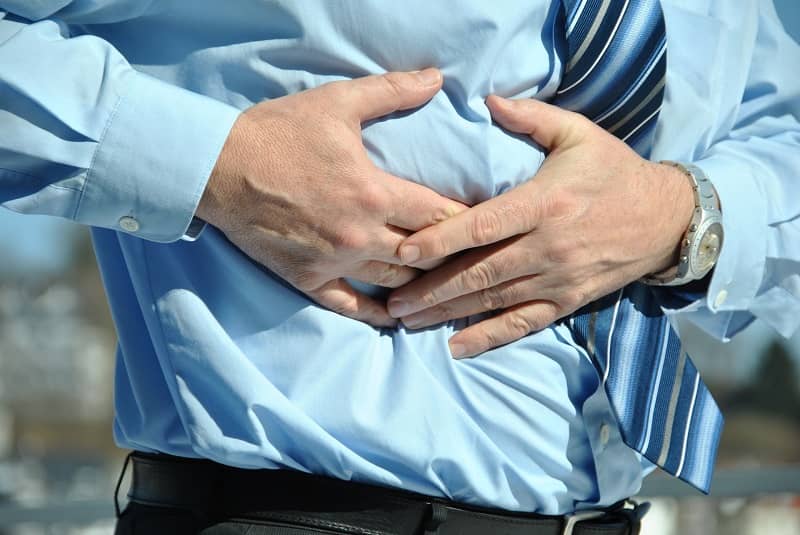
Gastric cancer has a slow onset. But before the development of a complete tumor, there are many precancerous changes in the gastric lining.
These changes are responsible for some of the symptoms associated with gastric cancer.
This cancer could affect any part of the gastric mucosa and hence show symptoms accordingly.
There are two main types of gastric cancer:
- Intestinal type – It is less severe and responds better to cancer treatment.
- Diffuse type – It is spread to various parts of the stomach as it spreads quickly. It is not a common type of gastric cancer and is often difficult to treat.
Stomach Cancer Symptoms
In earlier stages, gastric cancer does not show any major symptoms, which are usually not noticeable like:
- A feeling of fullness or satiety
- Mild stomach ache
- Fatigue
But gradually as cancer advances, the symptoms become serious.
The following symptoms that last for longer than 2 weeks are suggestive of gastric cancer.
- Weight loss – Despite sticking to the same routine, if your weight continues to drop, it’s time to ring the doctor.
- Abdominal pain – Can range from mild to severe pain.
- Nausea and vomiting
- Loss of appetite for more than two weeks
- Vomiting blood
- Stool assessment – One way of finding out if you are suffering from gastric cancer is by examining the color of your stool. Dark sticky stool suggests cancer.
Causes of Stomach/Gastric Cancer
The exact causes of gastric cancer are not yet known. But according to health experts, certain factors are responsible for the same:
- Diet: A diet rich in salty and processed foods with higher amounts of meat and fewer veggies is likely to cause chronic gastric irritation. Eating too much spicy food too can destroy the gastric lining. However, only chronic food patterns are responsible for affecting the gastric lining.
- Lifestyle: Too much alcohol and smoking can be responsible for many types of cancers including gastric cancer.
- Pyloric Infections: H.pylori is a microorganism responsible for microbial action on the lining causing bleeding and painful ulcers. This too can contribute to the development of cancer.
- Genetic factors: A family history of gastric/stomach cancer increases the risk of an individual getting cancer.
#5. Breast Cancer
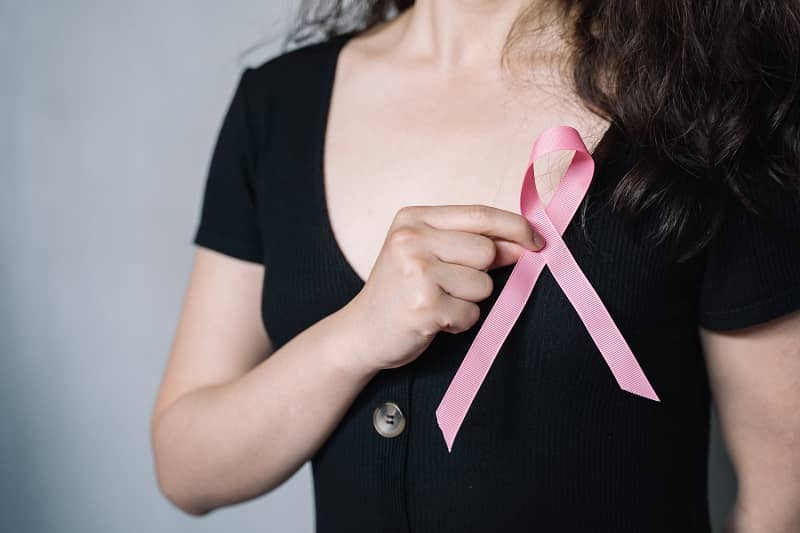
Breast cancer is the second most common cancer in women after skin cancer while not more than 1% of men fall at its risk.
Although the outwards appearance of breasts differs in men and women, they are built pretty much the same.
They even share some of the risk factors associated with breast cancer.
Generally, breast cancer is less common in men because male breast tissue is mainly of fats and fibrous tissue with fewer ducts and lobules.
On the other hand, now young females get breast cancer which was earlier known to be more common in older women. However, it is important to note that breast cancer is still more common in the older population.
The different types of cancer in women which come under breast cancer are:
- Invasive Ductal carcinoma – Originates from the milk ducts of your breasts and spreads to surrounding tissue.
- Ductal carcinoma – It is a precancerous stage and is often considered a stage 0 cancer because it is limited to the milk ducts.
- Lobular cancer – Forms in the lobules and can spread to surrounding tissues.
- Triple-negative breast cancer – It does not show the three major markers of breast cancer and hence is difficult to diagnose at an early stage.
- Inflammatory breast cancer – It is characterized by redness, swelling, and pitting of the breast skin.
Moving ahead we discuss the various symptoms that help in identifying breast cancer.
Symptoms of Breast Cancer
The symptoms that indicate the development of breast cancer range from mild to severe:
- Lumps and swellings around the breast region are different from surrounding tissues.
- Morphological changes in the shape, size, and appearance of the breast.
- Difference in the texture of the breast skin.
- The pigmented area around your nipple can show changes like areas of crusting and flaking.
- Patches of red and areas showing pitting over the breast surface.
Causes of Breast Cancer
There are three main causes of breast cancer:
1. Hormonal: Excess production of estrogen due to disorders or other factors can increase the risk of breast cancer and might even cause breast cancer. Often hormone replacement therapy too can cause breast cancer.
2. Lifestyle: Habits like smoking, excessive alcoholism, and a diet that doesn’t sustain healthy body functions for a chronic period can give rise to cancer.
3. Environmental Factors: Environmental factors including physical factors like excessive exposure to radiation at a younger age or high exposure of head, neck, and chest to radiation during therapy is also a causative factor.
Other than these factors, the most prominent reason that contributes to most of the cases of breast cancer is molecular or genetic factors.
The genes responsible for giving rise to breast cancer are BRCA 1 and 2.
Mutations in the above gene increase the risk of cancer even in men.
#6. Colon and Rectal Cancer

Also called colorectal cancer, it originates from the growth of polyp inside either colon or rectum.
So, the most effective way of preventing cancer is to eradicate the polyp as soon as possible.
Usually, the polyps give rise to cancer because of a series of abnormal mutations in their molecular DNA.
They don’t show symptoms until the polyp becomes large and cancerous.
Since cancer may exist without showing symptoms, people with polyps must go for regular colorectal screenings.
Colorectal Cancer Symptoms
The symptoms of colorectal cancer are usually absent and hence it is vital to undergo colorectal screenings to diagnose polyps.
As cancer advances, it shows several symptoms which could be used to trace cancer.
However, both stage 1 colon cancer symptoms and rectal cancer symptoms could be the same and hence screenings define the true location of cancer.
The Common Colon and Rectal Cancer Symptoms are:
Blood in stool is a common symptom of colorectal cancer. But sometimes it can also indicate other diseases. Also, certain iron-rich foods can give a reddish color to your stool.
Given that, here are some possible signs:
- Anemia – The symptoms of anemia can indicate various forms of cancer and colorectal cancer is one of them.
- Abdominal changes – Pain in abdomen, vomiting, and nausea.
- Bowel habits – Various changes in the bowel movements like constipation or diarrhea, inconsistency of the bowel, and narrowing of stools can indicate cancer.
But since most of these symptoms are also present in many other diseases, it is best to get a regular screening test done.
Causes of Colorectal Cancer
Cancer mainly develops from the polyps which are the mass of abnormal cell growth of cells. This is mainly because of mutations in the DNA of these cells.
Though there are many forms of polyps, cancers mostly originate from the adenomas and sessile forms of the polyp.
People at risk of this cancer are:
- People with a family history of colorectal cancer.
- Those suffering from chronic inflammation of the intestine like ulcers.
- People with diet habits containing high fat. Such diets for a longer period can cause a higher risk of colon cancer.
- Physical agents like radiation exposure.
#7. Prostate Cancer

Prostate cancer is the second most popular cause of death among men due to cancer.
This cancer type develops slowly, and even the early diagnosis of cancer before symptoms appear might not save a man’s life.
Cancer begins because of abnormal growth of the cells in the prostate and is mostly adenocarcinomas.
But there can also be other forms of cancer growing in the prostate like:
- Small cell carcinomas
- Sarcomas
- Transitional cell carcinomas
Symptoms of Prostate Cancer in Men
Cancer can show effects in various regions like:
- Pelvic region – Pain in the lower region.
- Penile area – Burning sensation during urination, weak urine flow, and painful ejaculation.
- Other body areas – Causes pain in the back, hips, and thighs.
Some other symptoms include blood in the urine, loss of appetite, and unexplained weight loss.
Causes of Prostate Cancer
The main cause of prostate cancer is the change in the DNA of normal prostate cells. This could be due to DNA mutations, either inherited or acquired.
Inherited mutations are when there is a family history of prostate cancer, and acquired cancer could be during the division of cells in the prostate.
The agents that can affect and speed up the mutations causing prostate cancer include:
- Tobacco products
- Chemical agents like drugs and steroids
- Physical agents like radiation
- Unhealthy lifestyle with poor diet practices.
Despite the dreadful risks all these cancer types pose to human life, they are diagnosable and treatable.
RELATED: How to Prevent Prostate Cancer
Diagnosis of Cancer
Most of the cancer cases are diagnosed post-identifying a tumor or after studying the signs of cancer in men and women.
Sometimes, general checkups for other medical conditions too can result in the revelation of a developing tumor.
Diagnosis of cancer usually involves:
- Physical examinations
- Laboratory diagnosis
- Tomography
- MRI
- Biopsy
#1. Physical Examination
The physical examination assesses the presence of lumps and swellings in different parts of your body that can indicate any developing cancer.
During the physical examination, the doctor also studies the enlargement of various organs.
#2. Laboratory Diagnosis
Laboratory diagnosis could be preparing smears of different fluids of your body.
In cases of lymphoma, your lymph is studied, and in leukemia, blood tests reveal the count of blood cells.
#3. Imaging Test
It mainly helps clear doubts regarding sarcomas as the imaging tests like tomography and MRI help in examining bones and internal organs. Such endoscopic examinations also help in locating the tumor.
#4. Biopsy
The biopsy is studying a part of the tissue scraped off from the tumor. It involves examining the tissue under the microscope to determine the stage of cancer.
Once the tests show positive for cancer, specific tests are done based on the type of cancer present in your body.
Post the diagnosis comes the treatment.
Treatment of Cancer
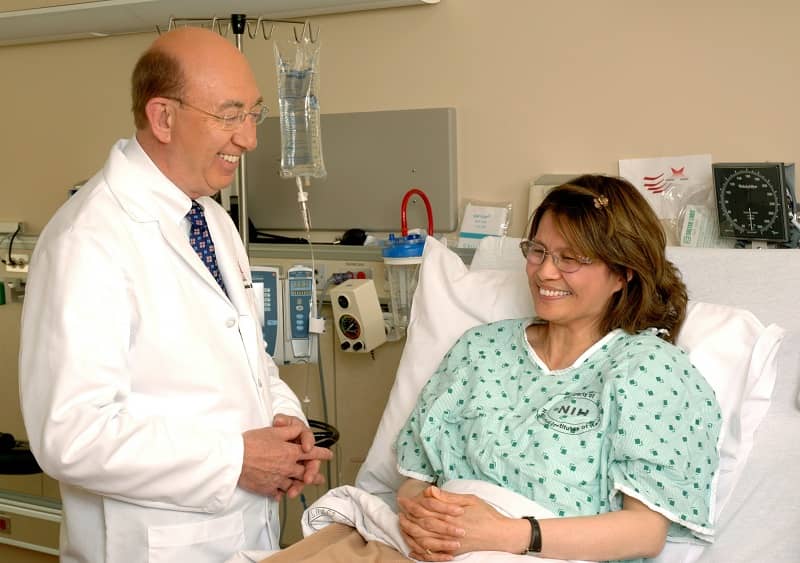 There are many different ways of treating cancer, but the type of treatment is chosen based on:
There are many different ways of treating cancer, but the type of treatment is chosen based on:
- Type of cancer
- Grade of cancer
- Stage of cancer
- Growth rate
The different types of treatment options of cancer are:
#1. Radiation Therapy
The therapy uses radiation of a high wavelength to kill cancer cells.
The main aim of using this therapy is to eradicate only the tumor cells and not the healthy cells.
However, this might cause side effects depending on the type, amount, and part of the body exposed to radiation.
#2. Chemotherapy
The therapy targets rapidly dividing cancer cells.
But unlike radiation therapy, they don’t work on a specific area, and there are effects are on the entire body.
Sometimes, it might even kill healthy rapidly dividing cells of the body. Chemotherapy could be a form of bacteria, vaccine, drugs, or antibodies.
#3. Hormone Therapy for Cancer
This therapy is only used for cancers that are dependent on hormones for their growth.
Moreover, it works in two ways:
- First, it stops the growth of cancer, and
- Second, it eases all cancer symptoms.
The treatment period with these methods can be accelerated by taking healthy measures of cancer support.
Cancer Support
Cancer support helps relieve the symptoms of cancer and improve quality of life even during cancer treatment.
Some of the healthy measures of cancer support are:
- Exercises – They reduce fatigue associated with cancer and reduce anxiety among patients. You can try brisk walking, swimming, and other suitable exercises.
- Mind and body synchronizing therapies – These improve your quality of life and encourage a happy life. Behavior therapies help alleviate pain, nausea, and vomiting.
- Balanced meals – A healthy diet helps prevent cancer and even accelerate the treatment period for cancer.
- Ancient remedies – Age-old remedies like acupuncture and acupressure can act as an accelerator for the treatment of cancer, speeding up the recovery. It also helps relieve the symptoms.
Final Take
Cancer, when detected at an early stage, is treatable and treatments can completely eradicate it. But if cancer is diagnosed at an advanced stage, the treatment becomes difficult.
Hence, it is always essential to be conscious of the changes in your body.
Going through a cancer symptom checker where various symptoms of cancer are listed can also be helpful in self-assessment for early diagnosis.
Sometimes, cancer types and symptoms are often confused with other symptoms and conditions. For example, signs of leukemia are often similar to other bleeding disorders.
In such cases, self-assessment is not possible and one must visit a doctor for confirmatory examination and further treatment.
So, I hope this blog has helped you develop a better understanding of cancer types, symptoms, causes, and treatment options.
Drop your queries down below and don’t forget to hit the like button if you found the blog useful.



No Comments